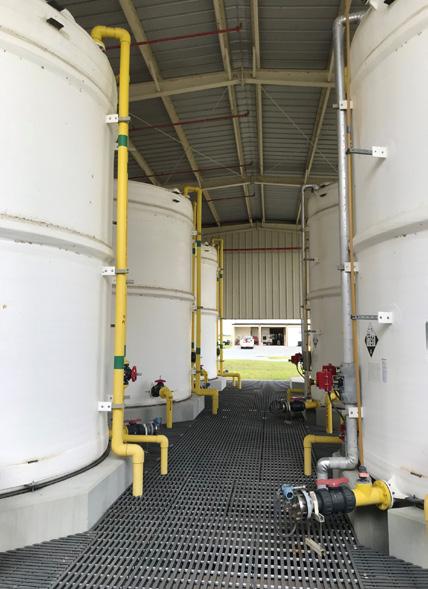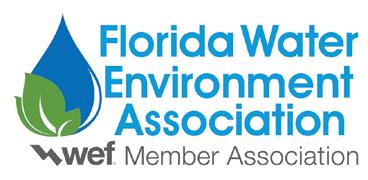
5 minute read
FWEA Focus—Sondra W. Lee
FWEA FOCUS Don’t Overly Disinfect Your Organization
Sondra W. Lee, P.E.
Advertisement
President, FWEA
When it comes to disinfection at the Thomas P. Smith Water Reclamation Facility (TPSWRF) in Tallahassee, the first thing that pops into my mind is how easy it is to forget about this part of the treatment process. It nearly fits into an “out of sight, out of mind” category. A system like this, which runs well and doesn’t demand too much attention, doesn’t happen without some planning, great teamwork, and a little bit of flexibility.
Planning
Prior to 2011, the TPSWRF was rated for 26.5 million gallons per day (mgd) of disinfected effluent using gaseous chlorine. Due to the dangers of elemental chlorine, personnel at the facility underwent a fair amount of training to maximize the safety of everyone there, but when planning was underway for a facilitywide upgrades project, the City of Tallahassee wanted to consider alternatives for disinfection.
A study was completed in 2008 and evaluated three options: gaseous chlorine, onsite generation, or delivery of 12 percent sodium hypochlorite. Ultraviolet (UV) was not considered due to the desire to deliver public access reclaimed water directly from the facility, which may require adding chlorine into the effluent to meet permit requirements.
Equipment Selection
Tallahassee decided to place safety concerns at the top of its criteria for disinfection alternatives. The 20-year present worth analysis for capital and operation and maintenance costs resulted in chlorine gas as the most cost-effective alternative. With the safety concerns of this option and the potential for significant future regulatory restrictions regarding the transportation of hazardous materials, Tallahassee discarded this option. It also discarded the second most cost-effective option to generate sodium hypochlorite onsite.
At the time of the study, technology to create sodium hypochlorite at treatment facilities was somewhat new and staff had concerns about issues in handling the hydrogen gas byproduct of the onsite process. The city decided it would rather wait a few years to let the technology improve; therefore, bulk delivery of sodium hypochlorite was selected, even though it was not the most cost-effective option when evaluating a 20year life cycle cost.
Ten years later, this appears to have been a great choice.
Teamwork
In general, the disinfection process at TPSWRF appears to operate trouble free. Admittedly, when compared to many processes at the facility, the disinfection system is rather simple, but when something runs well and doesn’t pose many problems, it’s so easy to forget about it.
A large part of the success is that the



operators, maintenance crew, electricians, and control technicians work at this facility not only take a lot of pride in their work, but they work together as a single team across the entire site. It takes time and effort to build a strong team, and this is important for leaders to keep in mind, too. When you can trust those well-maintained teams to continue their course, it’s easy to turn your focus to the more problematic areas of the organization.
I had this habit while serving as the operations supervisor. I used to think, if things ran well, then nothing needs to be said, since that’s how it should be. Over time I realized how important it is to not ignore your best team members and to speak up when you’re pleased with how things are operating, expressing gratitude for all the good work taking place.
Allow Experimentation
Aside from having a good maintenance program at this facility, team members feel comfortable with offering suggestions for further improvement. Most systems have operational procedures that need to be followed, but it doesn’t mean that adjustments cannot be made to the procedure. After the new disinfection facility was placed online the operations and maintenance teams collectively made some changes to improve the system.
Removal of Mixer
One of the first items to be removed was the inline mixer that discharged the bleach in a channel just upstream of the chlorine contact basins. These units appeared to corrode rapidly, and over time, the team felt that there might be enough turbulence in the channel to handle the mixing without the unit. After some experimentation, while staying in compliance, the team came up with a new static solution to feed chlorine to the channel, which is still in place today.
Change in Dosing Strength
Another staff-led change was made to the strength at which the sodium hypochlorite was dosed, eliminating a step in the dosing process. Sodium hypochlorite is delivered at a 12 percent solution and was diluted to 6 percent using softened water, making it easier for an operator to dial in the correct dosage without wasting excess chlorine. A fair amount of equipment was used in the dilution process that was often problematic and the team members asked if they could begin dosing at full strength.
Honestly, I had concerns that this would be a costly way to dose chlorine, but upon listening to the team members, and their commitment to monitor bleach usage and stay in compliance, we decided to give it a try. They were able to successfully demonstrate that this easier-to-maintain setup can deliver chlorine without excessive bleach usage.
Allowing team members to make suggestions and try out new methods has provided a system that continually improves, even though it was rather trouble free to begin with.
Flexibility, Not Complete Disinfection
It would be much easier for us to stick with the standard procedures, like purchases based only on a 20-year life cycle or holding fast to the designer’s operating protocols. The work involved to do something out of the norm can at first feel like it’s too much trouble. Also, not all suggestions and trials made by team members are successful. Our experience is that allowing some flexibility, while staying in compliance, has led to great improvements across the facility.
Starting out with equipment that has better reliability and that the team members feel comfortable with creates a base to a well-operating system. Setting up a culture of teamwork and good communication helps maintain the overall system. Most importantly, however, don’t completely forget about your low-maintenance systems and well-operating teams. Keep up a good balance between monitoring and autonomy, as long as compliance and regulations continue to be met. S











